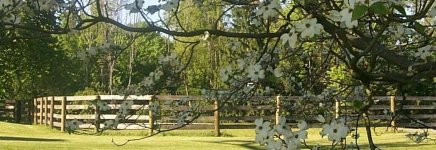OP
wroughtn_harv
Super Member
</font><font color="blue" class="small">( What did you use to fasten the wire to the poles? Did you run anything extra along the ground, or is the wire off the ground?)</font>
The only place we ran a bottom pipe rail was along the back property line. It backs up to a new subdivision with their contractor supplied stockade fencing. We didn't want the horses cribbing on the the neighbor's fences so we ran our fence a little over six feet high. We put in a bottom rail to help keep the horses from deforming the fabric as they maintained the growth along the property line. /forums/images/graemlins/grin.gif
V Mesh is like having a barbless barb wire every four inches. So it really doesn't need much support. The pipe top rail does two things. It gives the fence rigidity and support, important. But it's also a safety factor for the horses. It provides a visible barrier that the horse can see. This is also important.
I use formed hook twelve and a half gauge steel fence ties. I buy the eight and a quarter inchers by the case. Between the post having five and the eight foot section having five I use about ten steel ties per eight foot of pipe with fabric fence. Aluminum sucks for fence ties. It's for sissies. It doesn't work. It doesn't last. Did I mention I didn't like aluminum ties?
Building a framework for a fence, posts, braces, and top rail if used, is just part of it. Stretching, dressing, and then properly tying is just as important.
What is sad is most pipe fencing is done by welders. They assume the weld is the most important part of the fence. They're wrong. Fence installers assume their setting of the posts is the most important part. They're partly right. A good fence has to have the posts set right. If there's welding then it's got to be done right. And the fabric needs to be properly installed.
I have a three phase Miller Spectrum 1000 and an Esab 625 that runs on single phase. In fact I've ran the Esab off of the Trailblazer on the truck using compressed nitrogen for air in the field.
The very most important thing in my book in a when considering a plasma torch is dealer support. Any of the major labels work well. But with a plasma you learn the meaning of the word "consumables". That's the tips and parts that are sacrificial. They need to be reasonable and they need to be readily available.
With the Esab it's about fifteen to twenty dollars each time you burn up a pair. Letting a friend try out your torch can cost you twenty dollars a lesson. I'm looking right now at replacing the torch on my Esab because I allowed some rookies to play with it. It's my fault, my bill.
The only place we ran a bottom pipe rail was along the back property line. It backs up to a new subdivision with their contractor supplied stockade fencing. We didn't want the horses cribbing on the the neighbor's fences so we ran our fence a little over six feet high. We put in a bottom rail to help keep the horses from deforming the fabric as they maintained the growth along the property line. /forums/images/graemlins/grin.gif
V Mesh is like having a barbless barb wire every four inches. So it really doesn't need much support. The pipe top rail does two things. It gives the fence rigidity and support, important. But it's also a safety factor for the horses. It provides a visible barrier that the horse can see. This is also important.
I use formed hook twelve and a half gauge steel fence ties. I buy the eight and a quarter inchers by the case. Between the post having five and the eight foot section having five I use about ten steel ties per eight foot of pipe with fabric fence. Aluminum sucks for fence ties. It's for sissies. It doesn't work. It doesn't last. Did I mention I didn't like aluminum ties?
Building a framework for a fence, posts, braces, and top rail if used, is just part of it. Stretching, dressing, and then properly tying is just as important.
What is sad is most pipe fencing is done by welders. They assume the weld is the most important part of the fence. They're wrong. Fence installers assume their setting of the posts is the most important part. They're partly right. A good fence has to have the posts set right. If there's welding then it's got to be done right. And the fabric needs to be properly installed.
I have a three phase Miller Spectrum 1000 and an Esab 625 that runs on single phase. In fact I've ran the Esab off of the Trailblazer on the truck using compressed nitrogen for air in the field.
The very most important thing in my book in a when considering a plasma torch is dealer support. Any of the major labels work well. But with a plasma you learn the meaning of the word "consumables". That's the tips and parts that are sacrificial. They need to be reasonable and they need to be readily available.
With the Esab it's about fifteen to twenty dollars each time you burn up a pair. Letting a friend try out your torch can cost you twenty dollars a lesson. I'm looking right now at replacing the torch on my Esab because I allowed some rookies to play with it. It's my fault, my bill.
